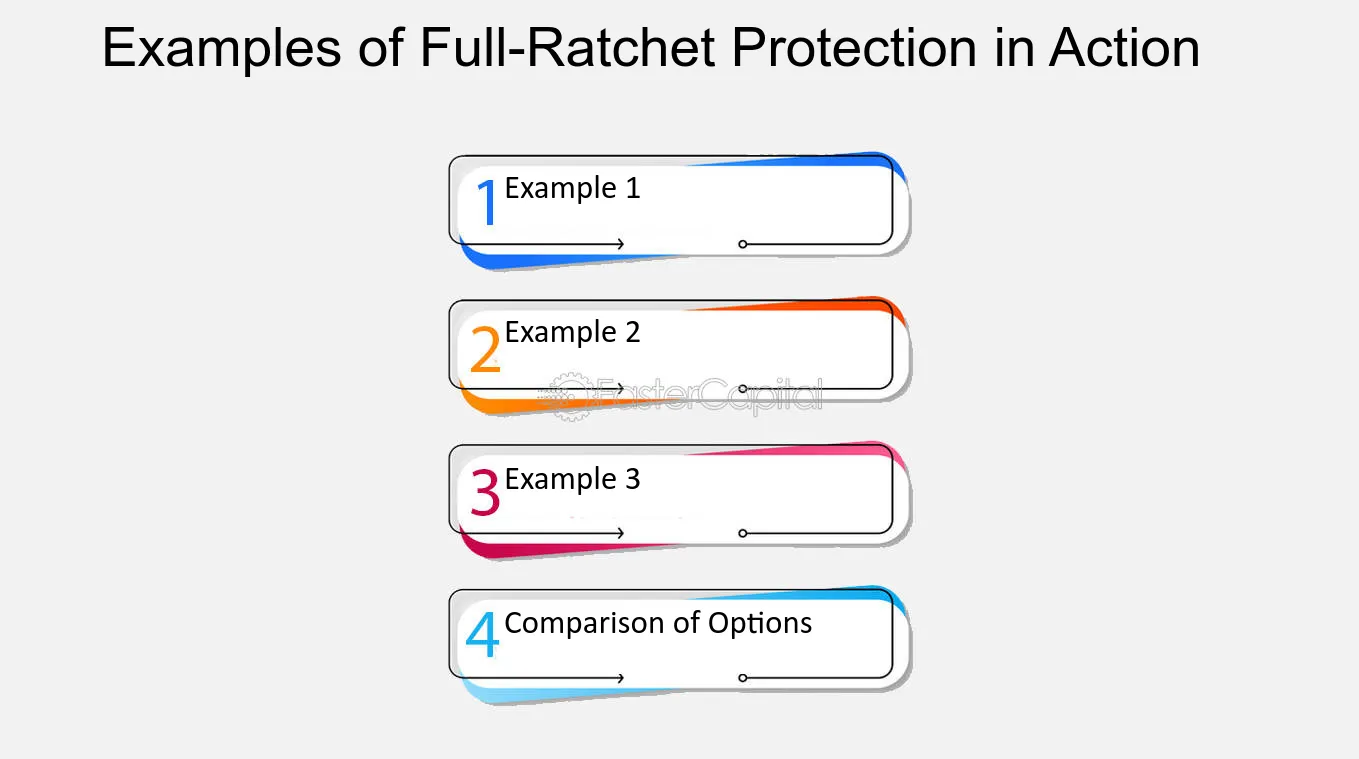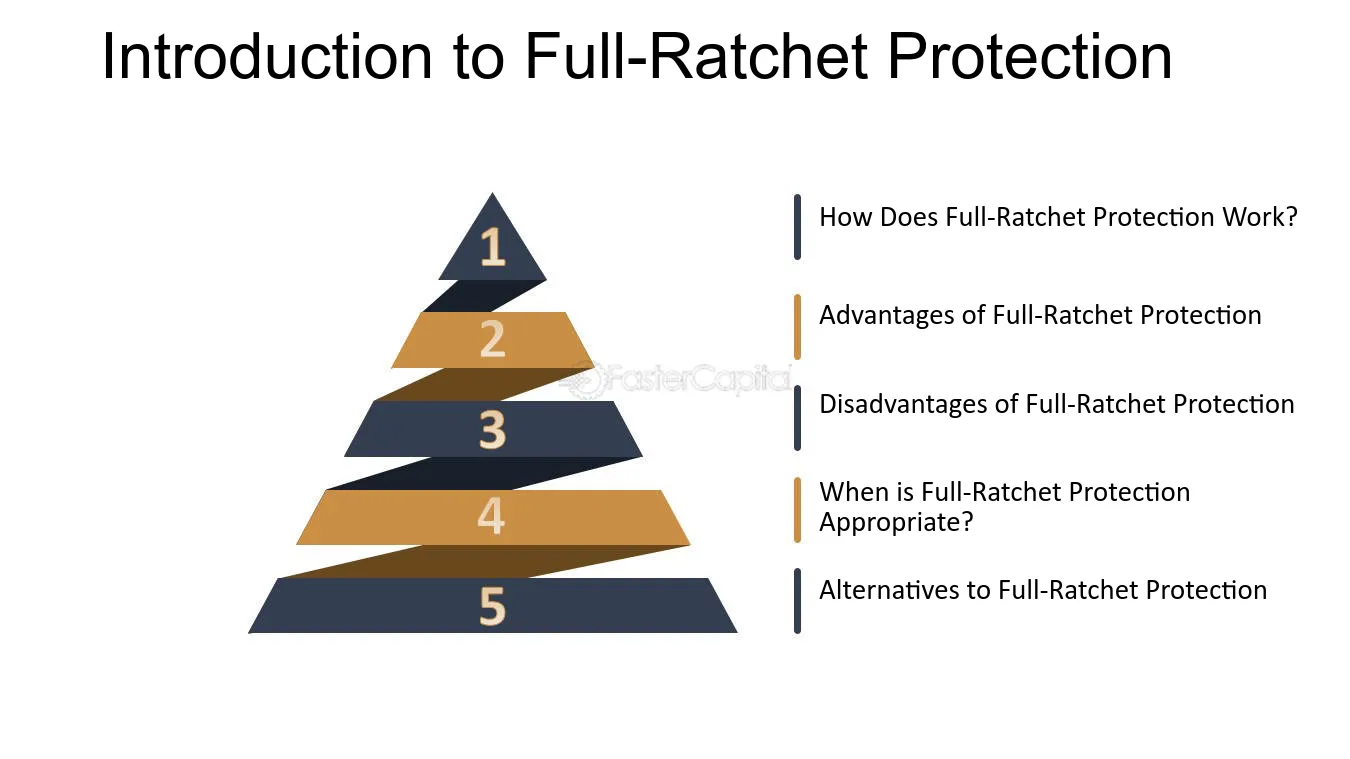Full Ratchet Anti-Dilution: Definition and Example
Full Ratchet Anti-Dilution is a mechanism used to protect the ownership percentage of early investors in a company during subsequent funding rounds. It ensures that the early investors’ ownership does not get diluted when new shares are issued at a lower price than their initial investment.
Here’s how Full Ratchet Anti-Dilution works:
- When a company raises additional funding at a lower valuation, the Full Ratchet Anti-Dilution provision kicks in.
- The provision adjusts the conversion rate of the preferred shares held by the early investors, effectively increasing the number of shares they own.
- This adjustment is based on the difference between the new lower price and the initial price paid by the early investors.
- The conversion rate is adjusted in a way that the early investors’ ownership percentage remains the same as before the new funding round.
Let’s illustrate Full Ratchet Anti-Dilution with an example:
Suppose an early investor purchased 10,000 preferred shares at $10 per share, representing a 10% ownership stake in the company. Later, the company raises additional funding at a lower valuation, issuing new shares at $5 per share.
Without Full Ratchet Anti-Dilution, the early investor’s ownership percentage would be diluted because the new shares are issued at a lower price. However, with Full Ratchet Anti-Dilution, the conversion rate of the preferred shares held by the early investor is adjusted.
Full Ratchet Anti-Dilution is a powerful tool for early investors to protect their ownership percentage in a company. However, it can also have negative consequences for later investors, as it effectively transfers the dilution burden to them. Therefore, alternative anti-dilution mechanisms, such as Weighted Average Anti-Dilution, are often used to strike a balance between protecting early investors and accommodating new investors.
Full Ratchet Anti-Dilution is a mechanism used to protect early investors from dilution in the event of future down rounds. It is a provision commonly found in investment agreements, particularly in venture capital deals.
When a company raises additional funding at a lower valuation than the previous round, it can result in dilution for existing shareholders. Full Ratchet Anti-Dilution helps mitigate this dilution by adjusting the conversion price of convertible securities, such as preferred stock or convertible notes, to the price of the new round.
How Full Ratchet Anti-Dilution Works
Under Full Ratchet Anti-Dilution, if a down round occurs, the conversion price of the existing convertible securities is adjusted to the price of the new round. This means that early investors will receive additional shares to compensate for the decrease in valuation.
For example, let’s say an investor purchased convertible preferred stock at a conversion price of $1 per share. If a down round occurs with a new valuation of $0.50 per share, the conversion price will be adjusted to $0.50 per share. As a result, the investor will receive twice the number of shares for the same investment amount.
Advantages and Disadvantages of Full Ratchet Anti-Dilution

Full Ratchet Anti-Dilution provides protection for early investors and ensures they are not unfairly diluted in the event of a down round. It allows them to maintain their ownership percentage in the company.
However, Full Ratchet Anti-Dilution can have negative consequences for the company and other shareholders. It can make it more difficult for the company to raise future funding as new investors may be hesitant to invest due to the potential dilution. Additionally, it can lead to significant dilution for existing shareholders if multiple down rounds occur.
Alternatives to Full Ratchet Anti-Dilution

While Full Ratchet Anti-Dilution is a common provision, there are alternative mechanisms that can achieve similar outcomes with less negative impact on the company. One alternative is Weighted Average Anti-Dilution, which takes into account both the price and the number of shares issued in the new round when adjusting the conversion price.
Another alternative is the Pay-to-Play provision, which incentivizes existing investors to participate in future funding rounds by offering them additional benefits, such as a lower conversion price or increased voting rights.
Example of Full Ratchet Anti-Dilution
Full Ratchet Anti-Dilution is a mechanism used to protect the rights of existing shareholders in a company when new shares are issued at a lower price than the previous round of financing. This mechanism ensures that existing shareholders are not unfairly diluted and allows them to maintain their ownership percentage in the company.
Let’s consider an example to understand how Full Ratchet Anti-Dilution works:
Scenario:

Company XYZ has raised its first round of financing at a valuation of $10 million. Investor A invests $1 million for a 10% ownership stake in the company. This means that Investor A owns 10% of the company’s shares.
Later, the company faces financial difficulties and needs to raise additional funds. It decides to raise a second round of financing at a lower valuation of $5 million. Investor B invests $1 million for a 20% ownership stake in the company.
Without Full Ratchet Anti-Dilution:
Without Full Ratchet Anti-Dilution, Investor A’s ownership stake would be diluted to 5% in the second round of financing. This is because the new investor, Investor B, is purchasing shares at a lower valuation, resulting in a larger ownership stake.
With Full Ratchet Anti-Dilution:
With Full Ratchet Anti-Dilution, Investor A’s ownership stake is protected. The mechanism adjusts the conversion price of Investor A’s initial investment to match the lower valuation of the second round. This means that Investor A’s ownership stake remains at 10% even though the company’s valuation has decreased.
Alternative to Full Ratchet Anti-Dilution
While Full Ratchet Anti-Dilution is a commonly used mechanism to protect investors from dilution, it is not the only option available. There are alternative methods that can achieve similar results without some of the drawbacks associated with Full Ratchet Anti-Dilution.
One alternative is Weighted Average Anti-Dilution, which takes into account both the price and the number of shares issued during a subsequent financing round. This method calculates a new conversion price based on the weighted average of the old and new prices, taking into consideration the relative sizes of the two rounds. This approach is considered to be more fair and balanced compared to Full Ratchet Anti-Dilution, as it takes into account the overall impact of the new financing round on the company’s valuation.
Another alternative is Broad-Based Weighted Average Anti-Dilution, which further protects investors by including all outstanding shares, including options and warrants, in the calculation. This method ensures that all shareholders are treated equally and prevents any specific group of shareholders from being unfairly diluted. It provides a more comprehensive and inclusive approach to anti-dilution protection.
Convertible Preferred Stock with a Cap is another alternative to Full Ratchet Anti-Dilution. This structure sets a maximum conversion price for the preferred stock, limiting the potential dilution for investors. This approach provides a clear and predetermined level of protection, without the need for complex calculations or adjustments.
It is important for investors and companies to carefully consider the different options available when implementing anti-dilution protection. Each method has its own advantages and disadvantages, and the choice should be based on the specific circumstances and goals of the parties involved.

Emily Bibb simplifies finance through bestselling books and articles, bridging complex concepts for everyday understanding. Engaging audiences via social media, she shares insights for financial success. Active in seminars and philanthropy, Bibb aims to create a more financially informed society, driven by her passion for empowering others.
